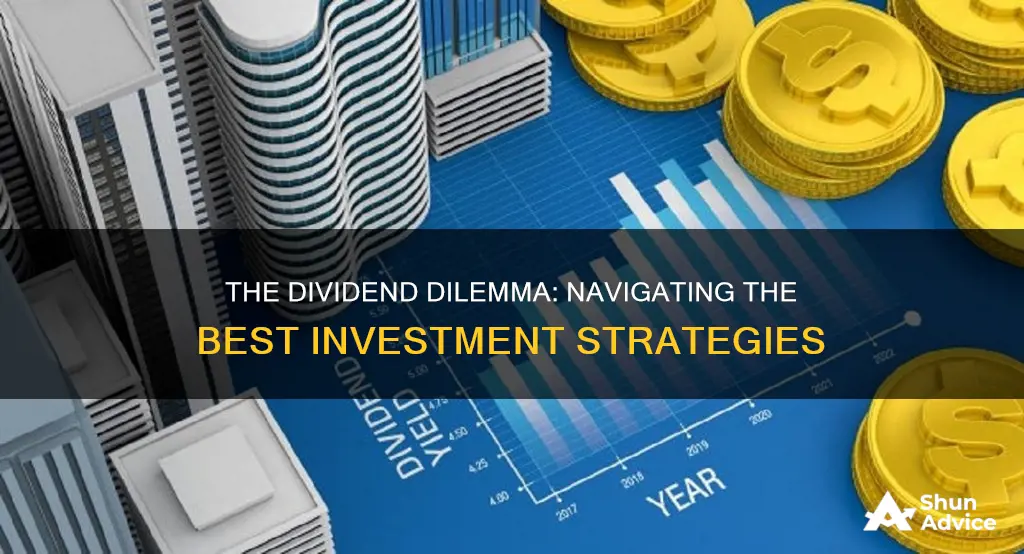
Dividend stocks are a great way to boost your investment portfolio and provide a source of passive income. Dividend-paying companies tend to be well-established, offering more stable and financially sound investments. Dividend stocks have historically outperformed the S&P 500 with less volatility, making them attractive to investors seeking lower-risk investments.
When considering which type of investment would pay the most dividends, it's important to look beyond the dividend yield, which is the annualised dividend represented as a percentage of the stock price. Instead, focus on the durability and reliability of the dividend. Look for companies with management teams that support their dividend strategies and have competitive advantages or economic moats. Additionally, consider the dividend payout ratio, which is the dividend as a percentage of a company's earnings, and the cash dividend payout ratio, which takes into account a company's free cash flow.
It's also worth noting that not all dividend-paying companies are created equal. Some companies with high dividend yields may be at risk of cutting their dividends if their business suffers, so be sure to research carefully.
To invest in dividend stocks, you can either choose individual stocks or opt for dividend funds, which hold a basket of dividend-paying stocks. When investing in individual stocks, look for companies with a history of increasing their dividends, stable revenue and earnings growth, and durable competitive advantages.
In summary, when seeking investments with high dividend payments, focus on the sustainability and reliability of the dividend, rather than solely chasing high yields.
What You'll Learn

Dividend stocks vs dividend funds
Dividend ETFs
Dividend ETFs (exchange-traded funds) are a collection of dividend-paying stocks. They are designed to track the performance of an underlying index, such as the S&P 500 Dividend Aristocrats or the Dow Jones Select Dividend Index. Dividend ETFs offer benefits such as ease of trading on an exchange, diversification, low expense ratios, and tax efficiency. They are passively managed, meaning investors don't need to spend time researching and analyzing individual stocks.
Dividend Stocks
Dividend stocks are issued by companies that regularly pay shareholders a portion of their profits in the form of dividends. Dividend stocks are usually issued by well-established, financially stable companies with a history of paying dividends. They can provide investors with a source of regular income and the potential for long-term capital appreciation. Dividend stocks are often favored by income-seeking investors and those with a more conservative investment strategy as they tend to be less volatile than growth stocks.
Dividend ETFs vs Dividend Stocks
Both dividend ETFs and dividend stocks offer income generation and carry similar levels of market risk. Dividend ETFs provide greater diversification and consistent income through the dividends paid by the underlying stocks. They also tend to have lower expense ratios than actively managed funds. On the other hand, dividend stocks allow investors to choose their own investments and may offer a higher yield than a dividend fund.
Dividend ETFs are a good option for retirees and income-seeking investors who want a low-cost, diversified, and reliable source of income. Dividend stocks may be better for investors who prefer to select their own investments and are looking for a higher yield. Ultimately, the decision depends on the investor's financial goals, risk tolerance, and investing style.
Immaterial Labor: Why Invest?
You may want to see also

High-dividend stocks
Dividend stocks are shares of companies that regularly pay investors a portion of the company's earnings. Some pay dividends annually, semi-annually or quarterly, while others are monthly dividend stocks. The average dividend yield of some of the top dividend stocks is 12.69%.
The best dividend stocks are shares of well-established companies that increase their payouts over time. Companies that pay dividends tend to be well-established, so dividend stocks may also add some stability to your portfolio.
- International Seaways Inc (INSW)
- Pennymac Mortgage Investment Trust (PMT)
- Franklin BSP Realty Trust Inc. (FBRT)
- Altria Group Inc. (MO)
- Verizon Communications (VZ)
- AT&T (T)
- Pfizer (PFE)
- Franklin Resources (BEN)
- Kraft Heinz (KHC)
- Starbucks (SBUX)
- Phillips 66 (PSX)
- Restaurant Brands International (QSR)
- Dynex Capital (DX)
- Enterprise Products Partners (EPD)
When investing in high-dividend stocks, it is important to consider the business quality and the company's ability to maintain and increase the dividend payout over time. Additionally, investors should focus on the dividend yield rather than the dividend size.
Nvidia: Buy or Bail?
You may want to see also

Dividend yield and other key metrics
Dividend yield is the yearly return on your investment. It is calculated by taking the annual dividend and dividing it by the stock’s current price. For example, if a company pays a dividend of $1 and its current stock price is $20, the dividend yield is 5%. Generally, a higher dividend yield is considered more attractive as it means that investors are receiving higher yields for less investment. However, higher yields can also indicate greater risk as they may reflect instability in a stock or a cash dividend departure.
The dividend payout ratio is the metric that measures how much of a company's earnings (net income) are paid out as dividends. It is calculated by taking the total dividends and dividing them by the company's total earnings. For instance, if a company's total profits were $100,000 and its dividend is $25,000, the dividend payout ratio would be 25%. If the payout ratio is too high, it means there is little room for error in the event of a downturn. Conversely, if it is too low (such as 0%), it is not a dividend stock.
Dividend growth is a metric that indicates how quickly a company is raising dividends over time. It measures the percentage increase in dividends over a certain number of years. For example, if a company raised its dividends by 10% over three years, the dividend growth rate over that time would be 3.3%. Investors generally seek out companies with a positive, consistently growing dividend.
The dividend streak shows how many years a company has paid the same or a higher dividend rate. It is a measure of how experienced the company is at providing dividends and how consistent they have been in increasing the dividend amount. A long dividend streak indicates stability and suggests strong financials and management.
Free cash flow is a fundamental measure of the cash a company generates after all its expenses. This metric is important when examining dividend stocks because it shows how much cash a company has available to pay out to shareholders in dividends. Companies with strong free cash flow generally have more money to invest in dividends, making them more attractive options.
The debt-to-equity ratio shows the amount of debt compared to the amount of owners' equity in the company. High debt levels generally indicate that a company has taken on too much leverage, increasing the risk that it may not be able to meet its dividend obligations. A higher debt-to-equity ratio is usually unhealthy as it indicates that management may be risking too much and could eventually face cash flow shortages.
In addition to these metrics, there are other factors to consider when choosing dividend stocks. Dividend stocks can be a great choice for investors looking for passive income. Companies that pay dividends tend to be well-established, so dividend stocks may add stability to your portfolio. Dividend yield can be calculated in a couple of different ways, depending on whether you are looking at individual stocks or ETFs. It's also important to note that dividends in taxable brokerage accounts are taxed in the year they occur, unlike stocks that do not pay dividends, whose taxation primarily occurs when the stock is sold.
REITs: Why Aren't More People Investing?
You may want to see also

How are dividends taxed?
Dividends are usually taxable income. The tax rate depends on the type of dividend, your filing status, and your taxable income. There are two kinds of dividends: qualified and nonqualified (or "ordinary"). The tax rate on nonqualified dividends follows ordinary income tax rates and brackets, which can be as high as 37%.
Qualified dividends are taxed at 0%, 15%, or 20%, depending on taxable income and filing status. To be considered qualified, a dividend must be:
- Paid by a US corporation or qualifying foreign entity
- Actually a dividend in the eyes of the IRS (some things that don't count as dividends include premiums that an insurance company pays back, annual distributions credit unions make to members, and "dividends" from co-ops or tax-exempt organizations)
- Held by the underlying security for long enough (typically if you owned the security for more than 60 days during the 121-day period that began 60 days before the ex-dividend date)
You should receive a Form 1099-DIV, Dividends and Distributions from each payer for distributions of at least $10. You use this information to fill out your tax return. You might also need to fill out a Schedule B if you received more than $1,500 in dividends for the year. Even if you didn't receive a dividend in cash—for example, if you automatically reinvested it to buy more shares—you still need to report it. You also need to report dividends from investments you sold during the year.
Nokia's Resurgence: Why Investors are Buying
You may want to see also

Dividend investment strategies
Dividend stocks can be a great investment option for those looking for passive income. They are shares of companies that pay investors a portion of their earnings regularly. Dividend stocks can be a good way to boost your investment portfolio, especially during high inflation.
There are two main ways to invest in dividend stocks:
- Dividend Stocks: This involves investing directly in the stocks of companies that pay dividends. You will need a brokerage account to place trades and choose which dividend stocks to invest in.
- Dividend Funds: These are mutual funds or exchange-traded funds (ETFs) that hold a basket of dividend-paying stocks. Dividend funds offer instant diversification and shelter you from having too much exposure to a single stock.
When investing in dividend stocks, it is important to consider the following:
- Dividend Yield vs. Size: Focus on dividend yield, which is the percentage of the share price paid as dividends annually, rather than the dividend size.
- Business Quality: Evaluate the business's ability to maintain and increase dividend payouts over time.
- Earnings Growth History: Ensure that the company's earnings have grown steadily and at a similar or higher rate than the dividend growth rate.
- Valuation: Be willing to pay a premium for high-quality businesses, but be cautious not to overpay, as it can impact long-term returns.
- Position Sizing: Determine how much of your portfolio you want to allocate to each stock, considering the level of risk and expected income.
- Long-Term Focus: Dividend stocks typically deliver better returns when held for the long term, allowing you to benefit from compound interest.
Additionally, there are a few key concepts to consider when evaluating dividend stocks:
- Payout Ratio: A low payout ratio (around 70% or less) indicates that the dividend is sustainable and the company is not paying out too much of its earnings as dividends.
- History of Increases: Look for companies that have a track record of consistently increasing their dividends, even during economic downturns or challenging periods like the COVID-19 pandemic.
- Steady Revenue and Earnings Growth: Prioritize stability by choosing companies with consistent revenue and earnings growth. Avoid erratic or fluctuating performance.
- Durable Competitive Advantages: Invest in companies with strong brand names, proprietary technology, high barriers to entry, or high customer switching costs.
- Supportable Yield: While a high yield is preferable, ensure that it is sustainable and supported by a healthy business and stable payouts.
Remember, investing in dividend stocks carries risks, and it's important to conduct thorough research and consult with qualified professionals before making any investment decisions.
The Mortgage and Investment Balancing Act: Dave Ramsey's Take
You may want to see also
Frequently asked questions
Dividend stocks are shares of companies that pay investors a portion of the company's earnings. Dividend stocks can be a great choice for investors looking for passive income.
You can invest in dividend stocks by opening a brokerage account. You can then choose to invest in individual stocks or opt for a dividend fund, which holds a basket of dividend-paying stocks.
Cash dividends are considered taxable income by the IRS. Qualified dividends, issued by a U.S.-traded company to shareholders who have owned the stock for more than 60 days, are taxed at the capital gains rate. Nonqualified dividends are taxed at standard income tax rates.







